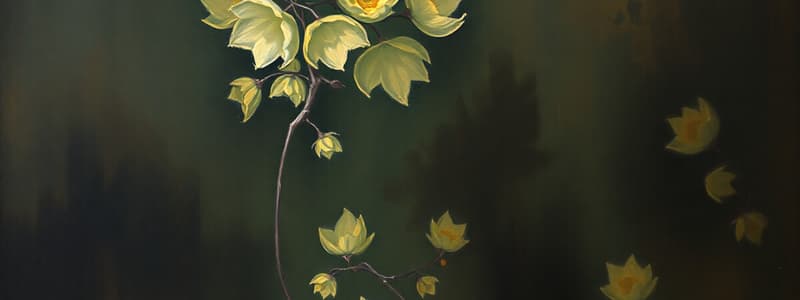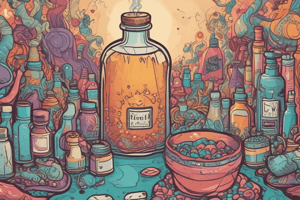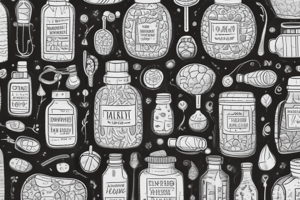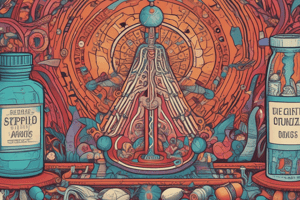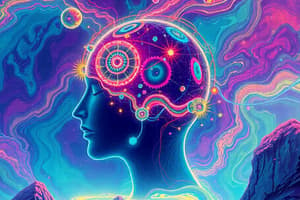Podcast
Questions and Answers
What is the primary psychoactive component found in cannabis?
What is the primary psychoactive component found in cannabis?
- THC (correct)
- DMT
- Psilocybin
- Mescaline
Which use of peyote cactus has been historically significant among indigenous peoples?
Which use of peyote cactus has been historically significant among indigenous peoples?
- For building materials
- In religious ceremonies (correct)
- For culinary purposes
- As a fiber plant for textiles
What effect does mescaline from the peyote cactus typically cause in users?
What effect does mescaline from the peyote cactus typically cause in users?
- Enhanced sensory perception and clarity
- Hallucinations and nausea (correct)
- Euphoria and high energy
- Relaxation and increased appetite
In which regions has cannabis historically been used for at least 3,000 years?
In which regions has cannabis historically been used for at least 3,000 years?
Which of the following mushroom species is known for its hallucinogenic effects?
Which of the following mushroom species is known for its hallucinogenic effects?
What form of cannabis comprises mainly flowers and upper leaves?
What form of cannabis comprises mainly flowers and upper leaves?
What historical event contributed to the banning of cannabis in the 1930s in the U.S.?
What historical event contributed to the banning of cannabis in the 1930s in the U.S.?
Which statement accurately describes the legal status of cannabis in Canada and Uruguay?
Which statement accurately describes the legal status of cannabis in Canada and Uruguay?
What is the primary use of betel palm as mentioned?
What is the primary use of betel palm as mentioned?
What phenomenon does the use of solanaceous drugs reportedly cause?
What phenomenon does the use of solanaceous drugs reportedly cause?
Which plant is recognized as a highly addictive stimulant used worldwide?
Which plant is recognized as a highly addictive stimulant used worldwide?
What is the primary danger associated with high doses of solanaceous alkaloids?
What is the primary danger associated with high doses of solanaceous alkaloids?
What are the effects of morning glory seeds due to lysergic acid derivatives?
What are the effects of morning glory seeds due to lysergic acid derivatives?
In what manner is tobacco predominantly consumed?
In what manner is tobacco predominantly consumed?
What traditional use of psychoactive drugs is frequently associated with human societies?
What traditional use of psychoactive drugs is frequently associated with human societies?
What positive health effect is suggested from chewing betel nut?
What positive health effect is suggested from chewing betel nut?
Flashcards
Psychoactive Drugs
Psychoactive Drugs
Substances from plants and fungi that alter mood, perception, and behavior.
Stimulant Drugs
Stimulant Drugs
Substances that increase alertness, energy, and activity.
Betel Palm
Betel Palm
A mild stimulant plant widely used in Asia
Tobacco
Tobacco
Signup and view all the flashcards
Hallucinogenic Drugs
Hallucinogenic Drugs
Signup and view all the flashcards
Solanaceous Drugs
Solanaceous Drugs
Signup and view all the flashcards
Scopolamine
Scopolamine
Signup and view all the flashcards
Morning Glory Seeds
Morning Glory Seeds
Signup and view all the flashcards
Peyote Cactus Use
Peyote Cactus Use
Signup and view all the flashcards
Cannabis Uses (Early)
Cannabis Uses (Early)
Signup and view all the flashcards
Cannabis Psychoactive Ingredient
Cannabis Psychoactive Ingredient
Signup and view all the flashcards
Cannabis Medicinal Use
Cannabis Medicinal Use
Signup and view all the flashcards
Magic Mushroom effect
Magic Mushroom effect
Signup and view all the flashcards
Fly agaric mushroom use
Fly agaric mushroom use
Signup and view all the flashcards
Cannabis popularity spread
Cannabis popularity spread
Signup and view all the flashcards
Cannabis Prohibition
Cannabis Prohibition
Signup and view all the flashcards
Study Notes
Psychoactive Drugs: Overview
- Psychoactive drugs from plants and fungi have been used by various cultures for religious rituals, hunger alleviation, and for their stimulant, depressant, and hallucinogenic effects.
- Medicinal and recreational uses of some drugs, like cocaine, overlap.
- Most psychoactive drugs are alkaloids that impact neurotransmission.
Stimulant Drugs
Betel Palm (Areca catechu)
- A mild stimulant widely used in India and Southeast Asia.
- Prepared by grating the nut, mixing with lime and spices, wrapping in a betel pepper leaf.
- Chewing can cause coughing and discolouration of teeth.
- Some evidence suggests it may prevent tapeworm infections.
Tobacco (Nicotiana tabacum)
- A highly addictive stimulant.
- Native to South America, part of the Solanaceae family.
- Used for 1600 years, introduced to Europe by Spaniards in the 1500s.
- Active ingredient nicotine is highly addictive and affects the central nervous system (stimulant and tranquilizing effects).
- Poisonous in high doses, a potent insecticide.
- Smoked as cigars, cigarettes, or pipes, and can also be chewed or snuffed.
- Hand-picked and cured for quality.
Hallucinogenic Drugs
Solanaceous Drugs (Tomato Family)
- Some plants in the Solanaceae (Tomato family) produce hallucinogenic deliriant drugs.
- Scopolamine, found in henbane, belladonna, and related plants causes a feeling of flying.
- Dangerous in high doses (nausea, convulsions, death).
Morning Glory (Ipomoea violacea)
- Seeds contain lysergic acid derivatives causing nausea, vertigo, constipation, and hallucinations.
- Used in Aztec rituals.
Peyote Cactus (Lophophora williamsii)
- Native to northern Mexico and the adjacent U.S.
- Contains mescaline, causing strong hallucinations and nausea.
- Used in Southwest American native religious ceremonies and for contacting the spirit world.
- Dried buttons traded among Native Americans.
Cannabis (Cannabis sativa)
- Used for 3000 years in China and India (for fiber, food, lighting, paint, etc.).
- Primarily known for psychoactive properties.
- Active ingredient: tetrahydrocannabinol (THC) in the resin of female plants.
- Forms include sinsemilla, ganja, and hashish.
- Popularized in Europe during the 1840s (artistic and literary circles)
- Used medicinally (chronic pain/nausea relief).
- Highly profitable (often illegal).
- Controversial health effects (psychological dependence, lung diseases and potential exacerbation of psychoses).
- Legal status varies globally. (Personal use tolerated in some places, medicinal use in others like the US and some European countries, legal in Canada & Uruguay).
Magic Mushrooms (Various Species)
- Some mushroom species cause hallucinations in small, controlled doses.
- Fly agaric (Amanita muscaria) used in Northern Asian rites.
- Various "magic" or "sacred" mushroom genera (e.g., Stropharia, Psilocybes, Conocybe, Panaeolus) have hallucinogenic and giddiness-inducing properties.
- Played a significant role in native ritualistic ceremonies in Central and South America.
Studying That Suits You
Use AI to generate personalized quizzes and flashcards to suit your learning preferences.
